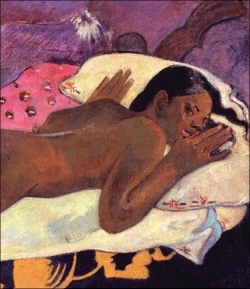Gauguin
Maker of Myth
Paul Gauguin is perhaps best known the way he wanted to be known. A driven and pioneering artist, he was also adept at creating a personal mythology that explained his life and artistry in story.
While the study and subject of myth has long been a part of visual artists’ aesthetic language, what is less commonly understood is the narrative process that some use to make sense of their own development and artistic influences. Post-Impressionist and early modernist Gauguin, for example, devoted his artistic life to the illustration and writing of a narrative about himself and about what influenced him visually, culturally, and symbolically. Gauguin: Maker of Myth traces the artist’s unique approach to storytelling. This beautiful publication accompanies the current Tate Modern exhibition which is also scheduled for the National Gallery of Art in Washington DC. The book is stunningly illustrated with more than 200 full color reproductions of paintings, works on paper, ceramics, woodcarvings, writings, sourcebooks, journals, letters, and personal effects.
While Gauguin’s paintings are frequently reproduced, often in larger formats, Gauguin: Maker of Myth is unusual in its inclusion of sourcebook material, not all of which is included in the exhibition itself. Readers looking only for coffee-table-sized reproductions of Gauguin’s more famous works should look elsewhere. This book speaks more directly to artists, teachers, and students who are seeking insight into Gauguin’s process of developing a body of work and identity as an artist. Images of cups, wood carvings, and other oddments that this book includes are difficult to find in other publications.
A number of perceptive essays by contributors such as Belinda Thomson, Tamar Garb, Charles Forsdick, Vincent Gille, Linda Goddard, and Philippe Dagen address the importance of varied cultural and personal myths to an artist who famously went into self-imposed exile at different phases of his artistic career. The text aims to decipher Gauguin’s views of the world he lived in, the effect those views had on his work, his attitude about other cultures, and his role interacting with them.
In “Paul Gauguin: Navigating the Myth,” Thomson illuminates how Gauguin continually recreated himself. As he became more convinced that he must be an artist, the tension between the colorful and bohemian lifestyle of an artist and his parallel existence as a dutiful family man became too much for him. He shed his bourgeois persona, changed his dress and behavior, and began to articulate an identification with his “savage” nature. Gauguin’s creation of this “native” myth later helped him to justify changes in his art. It also, however, impacted his relationship with his mentors and ultimately alienated many of his friends.
According to Thomson, Gauguin made use of his own life as a “narrative strategy” fueled by his upbringing abroad and his extensive travels. Gauguin was striving for recognition during a time when parading one’s individualism had become a kind of artistic currency, especially among such peers as Monet, Cezanne, and van Gogh. Gauguin began his career later than most artists and this development was propelled by an extraordinary level of self-belief. In his own words, “I am a great artist and I know it. It is because I am that I have endured such suffering. To follow this path otherwise I would consider myself a brigand. Which is what I am, moreover, in the eyes of many people.”
Additional essays address other facets of Gauguin’s artistic life. In “The last Orientalist: Portraits of the Artist as Mohican,” Vincent Gille discusses the impact that the dazzling colors, rhythms, and narrative modes of Victor Hugo’s volume of poetry, Les Orientales, had on Gauguin. A section of the book entitled “Fictions of Femininity” explores Gauguin’s use of female subjects. Gauguin sampled from his own cultural tradition and others for inspiration and narrative. He avoided more conventional allegories—such as peace, war, and industry—using instead a more personal set of themes: purity, life, virginity, and abandonment. During his time in Tahiti, he created a world of Polynesian legends and traditions mixed with his own version of Christian iconology. The women he painted in this world became timeless abstractions, influenced by the European Romantic tradition blended with Symbolism.
Gauguin: Maker of Myth unfolds a wonderful body of works and research for artists, historians, and art lovers. The book is beautifully designed and liberally illustrated with an attention that assists the reader in moving swiftly though a dense and plentiful history spanning several art movements.
Reviewed by
Pamela Ayres
Disclosure: This article is not an endorsement, but a review. The publisher of this book provided free copies of the book to have their book reviewed by a professional reviewer. No fee was paid by the publisher for this review. Foreword Reviews only recommends books that we love. Foreword Magazine, Inc. is disclosing this in accordance with the Federal Trade Commission’s 16 CFR, Part 255.

